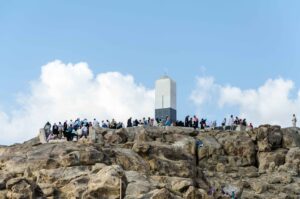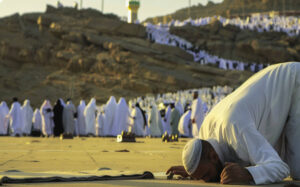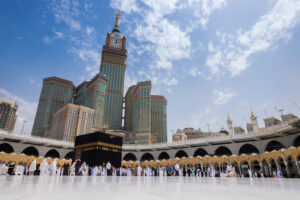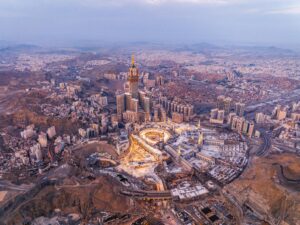Hajj is a deep journey in which Muslims come closer to Allah. Hajj consists of sacred rituals that begin with Ihram and end with the Farewell Tawaf (Tawaf al-wida). This article will outline the most important acts of Hajj, emphasizing Ihram, Tawaf al-Qudum (the circumambulation upon arrival), Sa’i between Safa and Marwah, and the stay at Mina.
Ihram: The Beginning of Intention and Purification
Ihram is the very first step of the Hajj journey; when the pilgrim enters a state of spiritual and physical purity to prepare for spiritual rituals. Ihram is initiated at designated Miqat points, where men wear two unstitched white garments, while women wear modest Islamic clothing without covering the face and hands. While in the state of Ihram, a pilgrim is prohibited from things like cutting hair, cutting nails, and having marital relations. Ihram symbolizes sincerity, humility, and renunciation of worldly life; it officially marks the beginning of their transformational spiritual journey.
Important Tips for Ihram:
- Make sure to intend (niyyah) before wearing the Ihram garments.
- It is preferred to say: “Labbayk Allahumma Hajjan” right after making the intention.
- Performing a ritual bath (ghusl) or ablution (wudu) before entering the state of Ihram is a confirmed Sunnah.
Tawaf al-Qudum (Arrival Circumambulation)
Upon arriving in Mecca, pilgrims undertake Tawaf al-Qudum – the welcoming circumambulation of the Kaaba, or one of the first acts undertaken inside the holy mosque. In a counterclockwise manner, the pilgrim walks around the Kaaba seven times, starting from the Black Stone, and reflecting on the importance of the place, and the nobility of the act that they are carrying out. Throughout the Tawaf, supplication and glorification of Allah (the Almighty) should be encouraged as these acts strengthen the connection between the worshipper and Allah (the Almighty).
Recommended Practices During Tawaf:
- Touch the Black Stone if possible, or gesture toward it.
- Men should uncover the right shoulder (Idtiba’) during Tawaf al-Qudum.
- Walk briskly (Raml) during the first three circuits for men.
- Make personal supplications during each round.
Sa’i Between Safa and Marwah
After completing Tawaf, the pilgrim proceeds to perform Sa’i between the hills of Safa and Marwah. This ritual commemorates the efforts of Hagar, who ran between the two hills searching for water for her son Ismail (AS). Pilgrims walk between Safa and Marwah seven times, recalling a story of patience and complete trust in Allah. This act symbolizes striving for sustenance and surrendering to Allah’s will, core values that enhance a Muslim’s faith and perseverance.
Steps of Sa’i:
- Begin by ascending Mount Safa and reciting the designated verses.
- Supplicate and praise Allah at both Safa and Marwah.
- Walk the distance between the two hills seven times, with brisk walking between the green markers for men.
- Make personal prayers and reflect on the story of Hagar throughout the ritual.
Mina: Day of Tarwiyah and Preparation for Arafah
On the 8th of Dhul-Hijjah, pilgrims travel to Mina for what is known as the “Day of Tarwiyah.” This occasion marks another day of posturing in a mental and spiritual state of preparation to conduct the ritual of Hajj at Arafah, the most important day of Hajj. Pilgrims spend the day performing shortened (qasr) prayers without combining them and spending the night there according to the Sunnah of Prophet Muhammad (PBUH). On the Day of Tarwiyah, the pilgrim prepares for the spiritual and special nature of Arafah. The Day of Tarwiyah provides the pilgrim with the opportunity to reflect, make supplications and seek forgiveness for sins.
What to Do in Mina:
- Engage in frequent remembrance of Allah and heartfelt supplications.
- Staying overnight in Mina is a strongly recommended Sunnah.
- Perform each prayer on time, shortening but not combining them.
These four rituals form the foundation of the Hajj journey. From the moment the pilgrim enters Ihram, to the Tawaf, Sa’i, and stay in Mina, each step represents a vital spiritual milestone. This sacred journey instills a profound sense of devotion, patience, sincerity, and sacrifice. Understanding these essential steps is key for every Muslim striving to fulfill this noble act of worship in accordance with the Prophetic tradition.
Comfort and Peace of Mind
With Dur Hajj, you gain access to the finest services and expert guidance to ensure a smooth, organized, and spiritually fulfilling Hajj experience. Our goal is to provide a seamless journey, allowing you to focus entirely on your worship without worrying about logistics, making your pilgrimage more peaceful and reassuring.
Benefits of Dur Hajj Services:
- 24/7 live support available to assist you anytime, anywhere.
- All-inclusive packages covering accommodation, transportation, and meals.
- A mobile application to track your schedule and important timings.
- Experienced religious guides to support pilgrims throughout the rituals.






